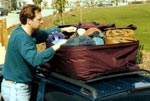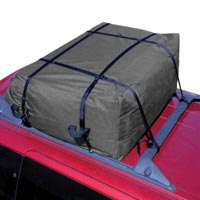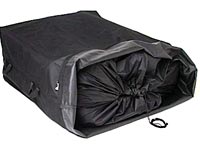Five Tips for Choosing a Car Top Carrier
By David Schaefer
Vacation season is here. Millions of Americans will be hitting the highway to see our nation's great parks, camp in the mountains or swim at our wonderful beaches. Most families face a dilemma: how to fit everything in the car. Families travel with friends and pets. When there are more people, there's sure to be more luggage and gear. Young people on the go with smaller compact cars and SUVs need to haul sports gear like bikes, tents, canoes and golf clubs.
How are you going to haul all that gear? Let me offer you these tips. First examine your car. Two big assets found on many vehicles are a factory roof rack or luggage carrier, and second would be a receiver - look for a small steel square hole under your back bumper, generally used for towing. (If you have neither, don't despair, see tip #5 below.)
If you have a luggage rack, you're in great shape. Generally, factory racks are rated from 75 to 250 pounds. It's important you check and follow the limit. Most any car top carrier bag can be strapped into any rack as long as it has raised bars. If your luggage rack has crossbars running the width of the car, you can also use either a roof basket or a rooftop cargo box. Consider the following when choosing a roof cargo solution:
|
1. Car
Top Carrier Bags are easy to install. Attach the
straps to your rack over the carrier and you're ready
to go. They fold up small when you're finished. Car top
bags should be packed full so the bag material doesn't
flap in the wind. The key to choosing a good bag is to
consider the material it's made from. Cheap bags are made
of thin material with flimsy zippers. Polyester material
is UV resistant and a good choice, while nylon carriers
will break down under the sun. Dual-layered material with
a vinyl backing really resists the water. Good car top
bags offer urethane coated zippers and liner systems as
additional measures to keep water off your gear.
2. Car
Top Baskets offer a sturdy structure to lift your
gear off of the vehicle rooftop. Roof baskets are easy
to strap cargo bags and nets to, and they offer a nice
rigid base with sidewalls. A basket paired with a car
top bag is a great setup offering the user much flexibility.
3. Rooftop
Boxes are very easy to pack. A roof box requires
a luggage rack with crossbars or a sport bar system on
your vehicle. They are generally the most expensive rooftop
option, and you have to consider whether or not you are
going to leave it on your car all the time or store it
in your garage. You'll need to pack them full or use a
net inside to hold the gear in place so it doesn't rattle
around. Make sure you pick a box that doesn't extend over
the front windshield to catch updraft. Also remember your
gear will be limited to the interior height of the box
or the box won't latch shut.
4. A new product called a Car
Back Carrier is a large cargo bag that hangs from
the luggage rack or steel car hooks on the back of the
wagons, suvs, and vans. It hangs under the rear window
so your view is not blocked. Car back carriers are easiest
to load, don't require much lifting, and also cause no
aerodynamic drag. Since they ride behind the car, they
don't get the extreme force of weather like rooftop carriers
do. They won't work with traditional sedans with trunks.
{Editor's note: In August 2008, a Great American
RoadTrip Forum member purchased this product and used
it on her family road trip. Click
here for her report!}
5. No luggage rack? No worries! Some car
top bags offer car
clips that can hook on ledges on the side of your
car and other car top carriers offer straps that
allow you to strap through the inside of the car and over
the carrier.
When using a rooftop carrier, remember total vehicle height when pulling into parking garages, drive-through spots, or even your own garage at home.
You are also in a good situation if your vehicle has a receiver. These are either 2- or 1¼-inch square steel mounts attached to the back of your car. You can use a receiver to mount cargo platforms, cargo boxes, bike racks and ski racks. Look for boxes and platforms with swing-out features that allow you to have access to the back of your car. Make sure to pay attention to the weight of your load and your receiver's weight rating.
Once you have a carrier, ask your crew to pack gear in medium-sized soft-sided suitcases and duffel bags. They are easier to lift and arrange. You can optimize your carrier's space better with smaller bags. You can find other packing and travel tips at LakelandGear.com.
David
Schaefer
6/23/06
 David
Schaefer is the owner of LakelandGear.com which designs, manufactures and sells car top carrier
bags and pickup truck tents. David's an Eagle Scout
and has been going on family road trips since the age
of six, when his dad made a wood and canvas rooftop
box to haul the family camping gear. He started the
business in Silicon Valley with the original PiggyPack
car top carrier and a US patent. His business and Internet
operations have grown and now include the newest "invention",
the Cargo Saddlebag. Currently David, his wife and two
daughters live in South Carolina. They travel as much
as possible testing and developing new carriers and
truck tents. David
Schaefer is the owner of LakelandGear.com which designs, manufactures and sells car top carrier
bags and pickup truck tents. David's an Eagle Scout
and has been going on family road trips since the age
of six, when his dad made a wood and canvas rooftop
box to haul the family camping gear. He started the
business in Silicon Valley with the original PiggyPack
car top carrier and a US patent. His business and Internet
operations have grown and now include the newest "invention",
the Cargo Saddlebag. Currently David, his wife and two
daughters live in South Carolina. They travel as much
as possible testing and developing new carriers and
truck tents. |




